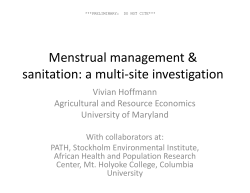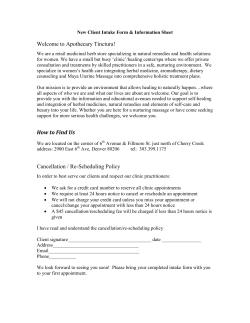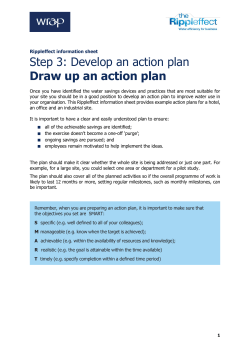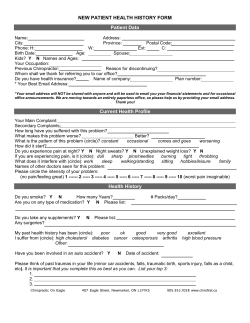
PRADARA
PRADARA The disease ASRUGDARA was known to mankind ever since the year of puranas. A vivid description regarding its aetiology, pathogenesis, symptomatology etc. are given in puranas. Description about streerogas are also available in Vedas and the management was mainly daiva- Vyapasraya. All Ayurvedic classics including Charaka Samhita, Susrutha, Samhitha, Ashtanga Samgraha, and later works like Bhavaprakasa, Yogatharangini, Bhasava Rajeeyam, Vangasena etc contain description of rekta pradara or asrugdara in detail. In Ayurveda a single disease may be known by different synonyms in different classics. This is true for Asrugdara also. Charaka Acharya has described its nidana, and samprati in detail in the chapter ‘Yoni Vyapat’ of Chikitsa Sthana (30th chapter)1. He liberally used the term pradara. Susrutha Acharya in Sukla Sonitha2 Adhyaya of Sareera Sthana described asrugdara as excessive menstrual bleeding. Vagbhata in ‘Puthrakameeya’ adhyaya of Sareera sthana3 has said that rakta yoni, asrugdara and pradara are one and the same disease. Where as in Ashtanga Hridayam description about rekta yoni is given and nothing is mentioned about asrugdara or pradara. NIRUKTHI (DEFINITION) Asrugdara is derived from two words4. 1. Asruk meaning blood or rekha. 2. Daram meaning stream or continuous excessive flow. Thus asrugdara means flow or stream of excessive blood flow. Various acharyas have defined asrugdara as follows. 1. Excessive flow during menstruation. 2. Prolonged flow during menstration. 3. Excessive flow occurring at menstrual or intermenstrual period. SYNONYMS 1. Pradara – due to pradeerana (excessive excretion) of rajas. 2. Rekta pradara – Pradeerana of rekta through yoni. 3. Rektayoni – Athisruthi (excessive flow) of rektha through yoni. Main symptom is excessive menstrual blood flow5. This disease is mainly described in Astanga Hridayam and Samgraham. Vagbhata I considers pradaram and Rektayoni as one and the same disease. 4. Asruja – Excessive flow of as asruk even after conception. Main symptom is excessive bleeding. This disease is described only in Charaka Samhita. It arises due to vitiation of rekta and pitha. Bleeding may be of prolonged duration as it is said that the bleeding occurs even after conception. As asrugdara is caused by multiple factors a through knowledge of nidana, poorva rupa, samprati, lakshnas, and upasaya enable the physician to beeter understand the disease and thus prevent its progression. Nidana (Aetiology)6 Nidana can be divided into 1. Sannikridhta nidana and 2. Viprakrishta nidana. Sannikrishna nidana is dosha prakopa and is brought about by viprakrishta nidana. The latter is further devided into 3. 1. Aharaja 2. Viharaja 3. Kalaja The aetiological factors of asrugdara can be grouped into 1. Factors which vitiate doshas 2. Factors which vitiate rekta 3. Factors which vitiate both General aetiology (Samanya nidanam) A. Aharaja 1. Excessive intake if lavana (salt) amla (sour) and katu (pungent) rasas. 2. Excessive intake of food having the characters of guru (heavy) snigda (unctousness) and vidahi. 3. Regular use of mamsa such as gramya mamsa, odaka mamsa. 4. Regular use of madya, dadhi, sukta, mastu. 5. Use of krisara and payasa excessively. 6. Use of virudha (incompatible) ahara. 7. Intake of food before the digestion of previous food taken (Adhyasana). B. VIHARAJA 1. Doing work more than one’s own strength. (Ativyayamam) 2. Running, riding etc. 3. Day sleeping (Diva swapna) 4. Weight bearing 5. Excessive coitus (Athi maiduna) 6. Excessive thinking, worrying C. KALAJA 1. Sarat kala 2. Afternoon Specific aetiology (Visesha nidanam) Excessive use of rooksha (dry), cold and astringent foods, hard working, weight bearing etc are specific aetiological factors for provocating vata and leads to vataja asrugdara. Excessive use of amla, lavana, kshara and agni sevana etc leads to pithaja asrugdara. Regular and excessive use of guru, snigda, Seetha ahara and divaswapna etc. leads to vitiation of kapha and terminates in kphaja asrugdara. Due to the aetiological factors above described, doshas are vitiated and also the dushyas mainly rekta, and deranges the rthu chakra, leading to the abnormality of arthava, resulting in asrugdara. Women suffering from gynaecological disorders, (yoni rogas), infertile women (vandya) and one who had repeated abortions are more prone to get asrugdara. Poorva roopa Poorva roopa or prodromal stage are those symptoms and signs, before the actual manifestation of the disease. It is otherwise called as sthana samsraya state (Fourth kriyakala). Due to sroto vaigunya, the kicakisation if vitiated doshas in particular areas of body takes place and the dosha – dushya samoorchana occurs. In pradara, poorva roopas are not seen. Since asrugdara is a disease with the cardinal feature of excessive menstruation, the prodormal stage which is occurring before menstruation is generally insignificant. Classification of pradara7 In Ayurveda, diseases are classified as per doshic predominance. Pradara is classified into four types 1. Kaphaja 2. Pithaja 3. Vataja 4. Sannipathaja Susrutha acharya has not given any classification. But has said that treatment should be based on doshic predominance or character of rekta vitiated by different doshas. This is emphasised by Vagbhata also. Consisting these openions, dwidoshaja asrugdara should also be included in the above list. Charaka acharya has described the treatment for vatapitha pradara, indicating the importance of dwidoshhaja type. But in critical analysis it can be seen that, the main dosha being vata and main dushya being rekta and wherever rekta is vitiated, one can expect the vitiation of pitha also, as there exists an asruya – asrayee bandha. So vitiation of pitha is a rule in all types. Thus it is better to avoid dwidoshaja variety and accept the four varieties of pradara. Roopa (Lakshana) Disease is indicated by the symptoms. Roopa or state of menifestation of a disease is the fifth stage of shad – kriyakalas of Susrutha. Lakshanas can be devided into two 1. Samanya lakshanas 2. Vishesha lakshanas 1. Samanya lakshanas 1. Excessive menstrual/intermenstrual bleeding. 2. Pain all over the body 3. Pain accompanying menstruation. 2. Vishesha lakshas Vishesha lakshas arise from specific dosha dushti. Kaphaja pradara. Menstrual blood in slimy, heavy, unctuous, cold, pale and discharged with mild pain. Associated features like vomiting, distaste, anorexia, dyspepsia, cough and dysnoea are also present. Susrutha acharya has said, in addition to the above symptoms of menstrual blood passage of clots or threads, vasa gandha, and dalty taste will also be present in arthava. Pithaja pradara Menstrual blood is bluish red or yellowish red, hot continuous flow, and there is intermittent pain. Susrutha acharya has said that, since these is continuous blood flow, clots are usually absent, and it smells like gomuthra and has got a pungent taste and looks like makdhika. Associated general symptoms present are burning sensation, increased body temperature, thirst, vertigo and loss of consciousness. Vataja pradara Menstrual blood looks like thin, dry, pale and blakish red. Additional symptoms of menstrual blood mentioned by susrutha acharya are; it is cold to touch, flows rapidly without clots and is clear. It has got astringent taste and loha gandha. Associated general symptoms includes intense pain at back, lower abdomen, sides, inguinal region etc. Excessive flow may or may not be associated with pain. Table shows symptoms Vataja, Pithaja & Kaphaja pradara Vataha Features 1. Color Pithaja Kaphaja Blackish red Yellowish red Pale red 2. Appearance Thin & frothy Viscous but not Heavy & clotted clotted on with threads 3. Nature of flow Speedy Continuous Slow 4. Pain Intense Intermittent Mild 5. Feel to touch Dry and cold Hot Slimy & cold 6. Taste Astringent Pungent Salty 7. Smell Loha Gandhi Matsya Gandhi Vasa Gandhi 8. Associated features Pain on black Increased Vomiting sacral region temperature dyspepsia, low abdomen thirst, burning swasa, kasa sensation, vertigo Sannipathaja pradara In Sannipathaja type, all the features mentioned above will be present. Menstrual blood is foul smelling, slimy yellowish and with burning sensation, flow looks like sarpee (ghee) or majja (bone marrow). Samprathi (Pathogenesis) The manner in which dosha-dushya samoorchana takes place, leading to the manifestation of a disease is termed as samprapti. This evolution stage starts with chaya (accumulation of doshas at their own place) and end in Vyakti of bheda. Thus the complete picture of a disease is the vitriated doshas and morbid condition of one or more tissues and organs of the body. Pradara is included under one of the rekta doshaja vyadhes. The moola sthana of rekta vaha srotas are yakrit and pleeha. The defective function of these organs leads to rekta dushti and dosha dushti, mainly pitha dushti. Excessive in take of amla, lavana, katu rasas, madya, sukta and sura etc will increase the pramna (quantity) of rekta and this rekta instead of circulating to all body parts equally, passes more through arthava vaha srotas. This abnormal passage of blood through arthava vaha srotas is hinted by Bhela acharya as dushta marga pratipanna sonitha. Thus the quantitatively increased and qualitatively changed rekta along with pitha will pass through sookshma siras of rektadhara kala of garbhasaya and covers or obstructs the apana vata. Thus the vitiated apana vata excretes the dushta arthava through yoni marga as excessive menstrual bleeding. The character of menstrual blood and its flow will vary according to the degree of vitiation of doshas. Diagram Shows the Samprati of Asrugdaram Sanchaya Nidana Rekta increases in quantity Vata Vitation Passes through Rekta vaha srotas Prakopa & Prasara Artharva vaha srotas Sookshma siras of garbhaasaya Sthanasamsraya Rektadhara kala Avarana of Vata by pitha Vyakthi Bheda Excessive bleding Asrugdaram Upadravas (Complications)8 Upadrava or complication is defined as a symptom or a disease which has its origin in the original disease and which is developed after the primary disease. Dourbalya (weekness), bhramam (giddiness), moorcha (unconsciousness), mada (psychosis), thrisha (thrist), daha (burning sensation of body), pralapa (delereum), pandu (anaemia), thandra (uneasiness or sleepiness), akshapaka (convulsions) and disorders of vata, sopha (oedema) etc are the complications of pradara. Most of the upadrava vyadhese of pradara arise from the excessive menstrual bleeding and to dhathu kshaya, and dosha dushti. This may lupset the psychology of the women, exaggerating the symptoms. Sadhya – Asadhyata (Prognosis) Sannipathaja pradara is asadhya or incurable. Women suffering from excessive continuous menstrual bleeding, suffering from thirst, having very short internenstrual period are also considered asadhya, according to Madhava acharya. All other types are sadhya or curable. Vyava cheda nidana (Differential diagnosis) 1. Arthava dusthi In arthava dusthi, symptoms and signs of arthava vitiated by single or combination of doshas are described. They represent only a temperory pathological condition. They do not cause any associated general symptoms. Even though the characteristics of discharged menstrual blood in arthava dushtti resemble that of pradara, but the excessive menstrual bleeding, irregularity of the rthu chakra and associated symptoms are only seen in pradara. 2. Vatiki Vataki pradara has to be differentiated from vataki yoni vyapth in vataki, characteristics of menstrual blood resembles that in vatika pradara but excessive bleeding and inter menstrual bleeding are not seen. Local symptoms like the feeling of displacement of vamkshana are seen in vatiki. References 1. Ch. Sam. 30/209 Chakrapani 2. Su. Sam. Suklasonitha adhyaya S. Sthana 3. A. Sam. Sareera Sthana 4. Ch. Sam. Chi. 30/206 5. Ash. Hri. Ni. 26/45 Arunadatta tika 6. Ch. Chikitsa 30/204 7. Ch. Chi. 30/211 8. Su. Sa. 2/16
© Copyright 2025









